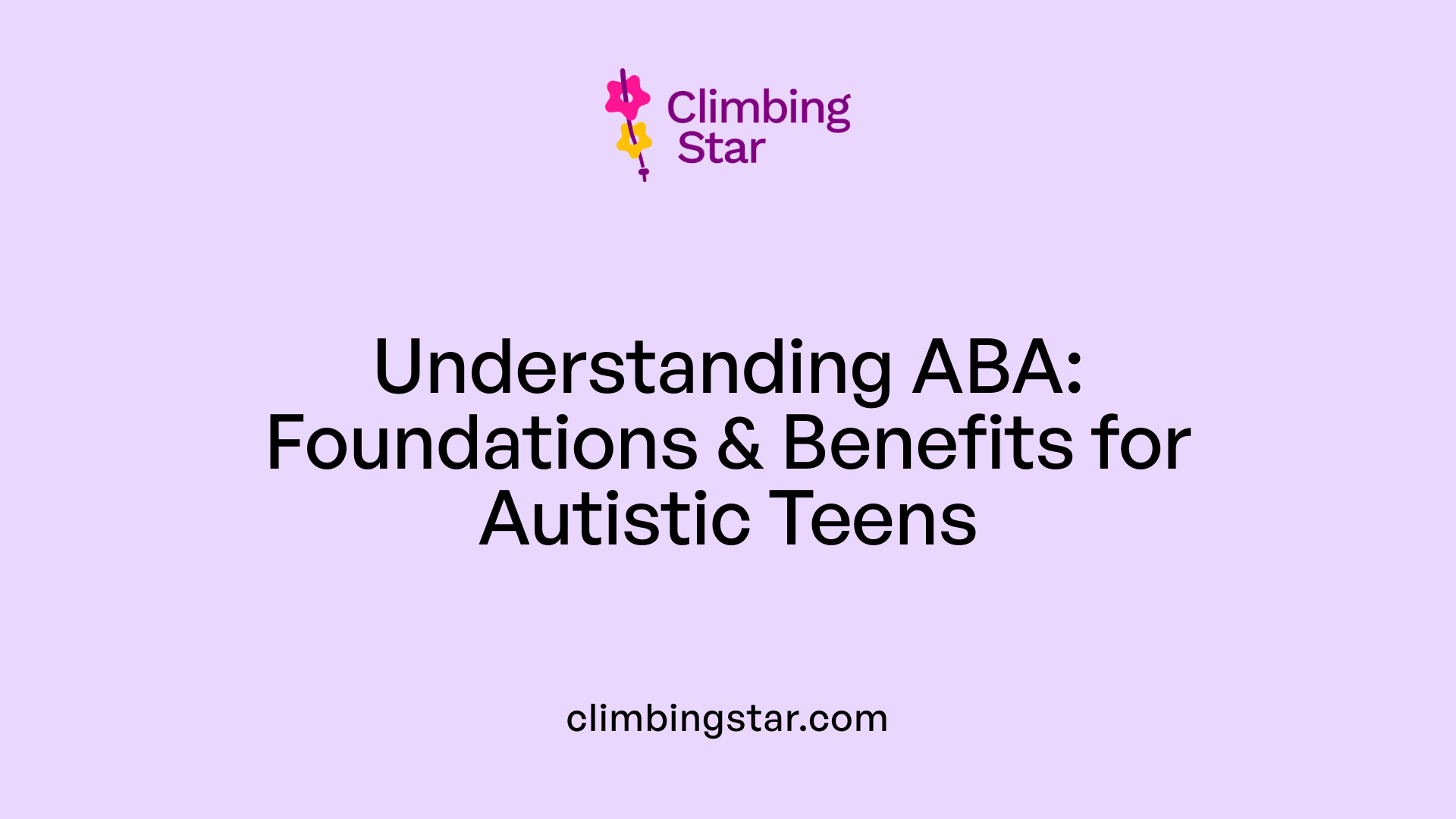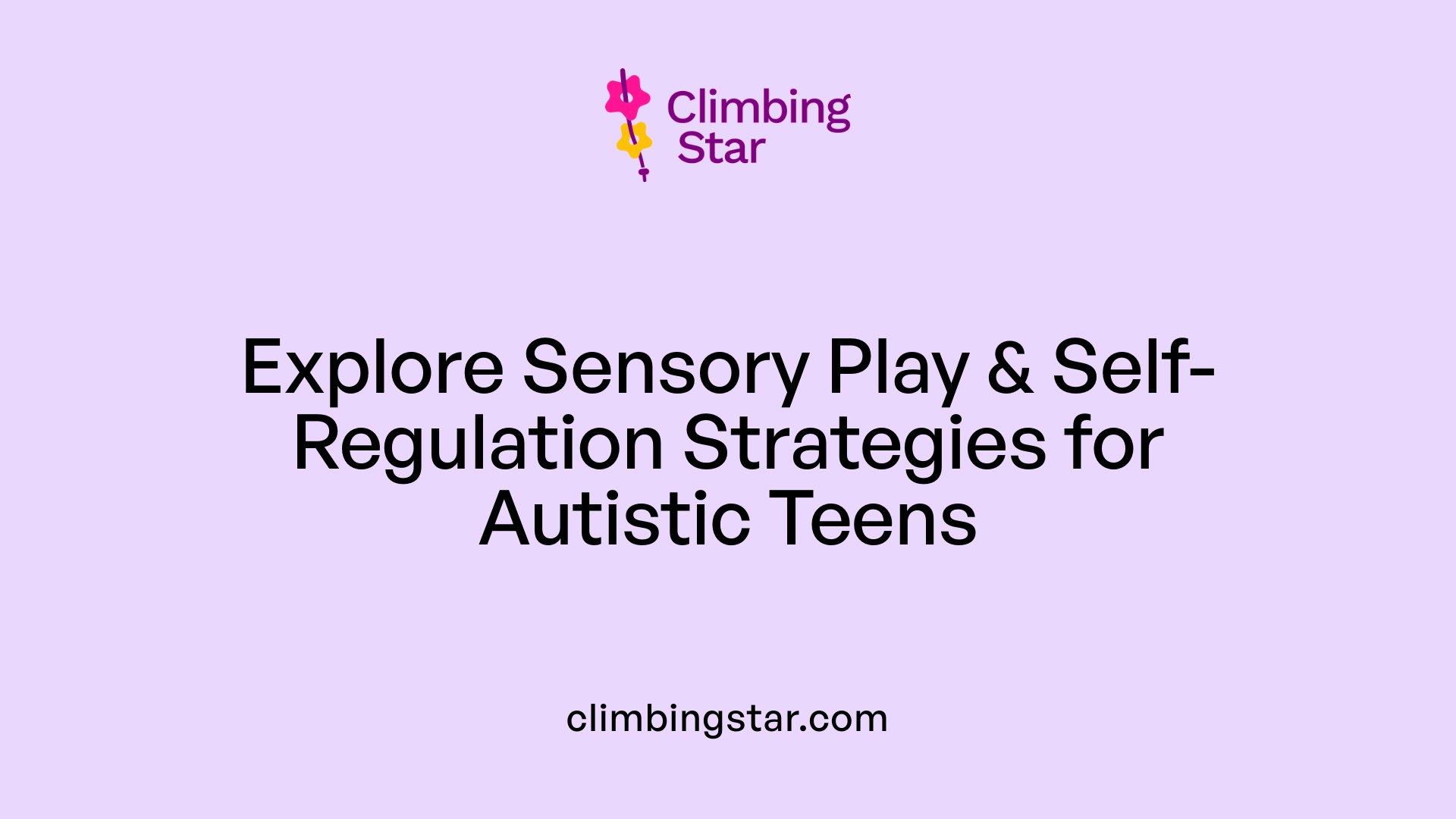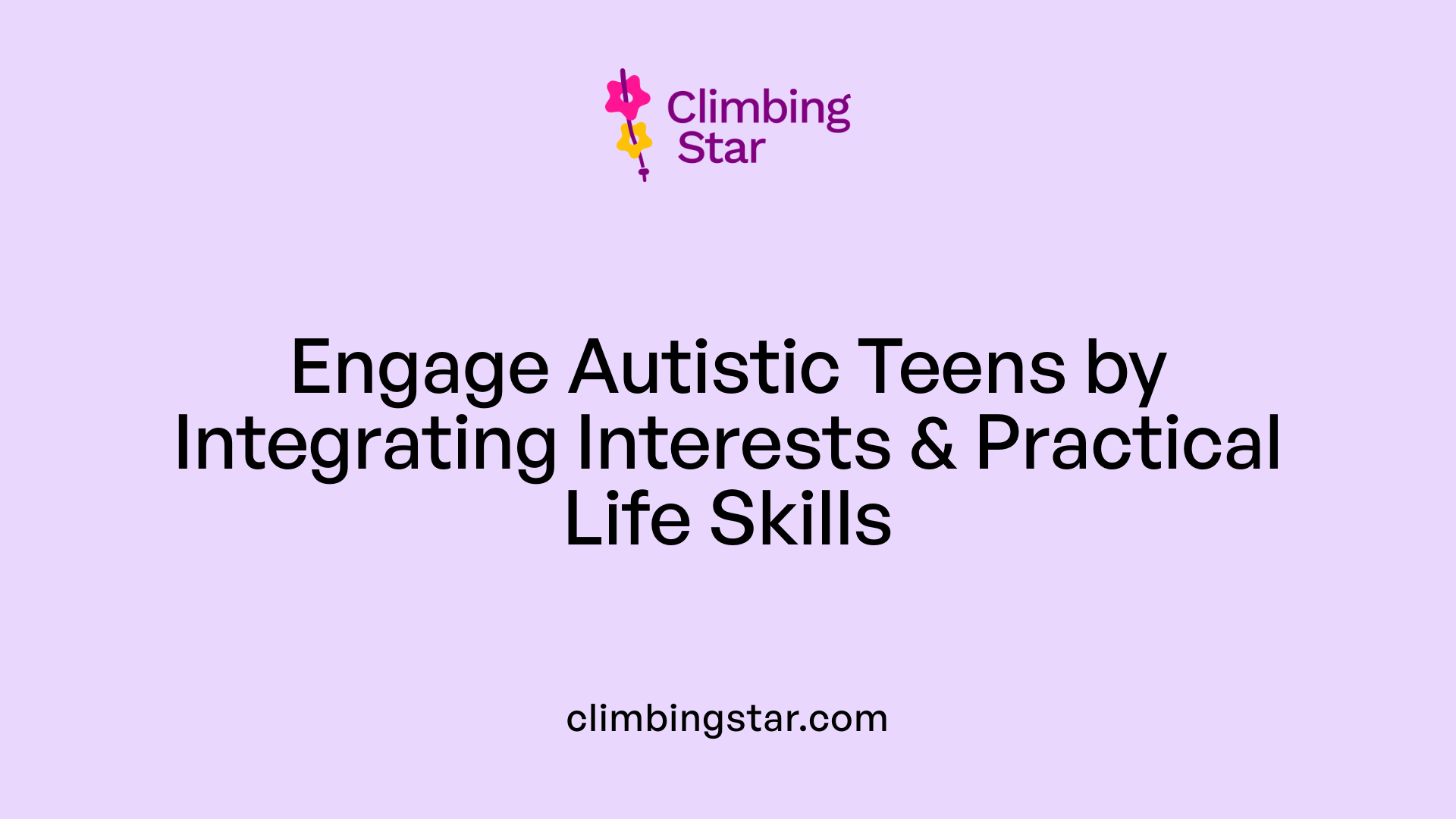Understanding Autism and the Importance of Specialized Activities for Teens
Autism Spectrum Disorder (ASD) affects communication, social interaction, and behavior in diverse ways, presenting unique challenges and strengths for each individual. For teenagers on the spectrum, activities that support emotional regulation, social skills, sensory integration, and independence are vital. This article explores a range of therapeutic and recreational activities that cater specifically to autistic teenagers, aiming to enhance their development, well-being, and social inclusion through evidence-based approaches and everyday practices.
Applied Behavior Analysis (ABA) Therapy: Foundations and Benefits for Autistic Teens

What is Applied Behavior Analysis (ABA) therapy and how is it used in autism treatment?
Applied Behavior Analysis (ABA) therapy is a science-driven method focusing on understanding how behavior relates to the environment. It aims to promote socially important behaviors and reduce harmful or disruptive ones in individuals with autism. This therapy uses positive reinforcement to encourage desirable actions, shaping skills in communication, social interactions, self-care, and academics.
Key techniques and approaches
ABA uses several core techniques including prompting, modeling, and naturalistic teaching strategies. Techniques such as Pivotal Response Treatment and the Early Start Denver Model are integrated for effective outcomes. Positive reinforcement is central, where rewarding progress reinforces learning. Therapists tailor strategies based on each individual's interests, often using everyday toys and materials to engage and motivate.
Settings and individualized program design
ABA therapy programs are highly individualized and can take place in different environments — at home, in schools, or community settings. Qualified Board Certified Behavior Analysts (BCBAs) oversee these personalized plans, ensuring that goals align with the child’s unique strengths and challenges. Parent involvement through training and coaching is an essential part of reinforcing skills and managing behaviors beyond therapy sessions.
Role in improving communication, social skills, and independence
ABA therapy systematically targets skill development to improve communication abilities, social engagement, and independence in daily living tasks. For autistic teens, it often involves conversation exercises, visual schedules, and task charts. By promoting functional skills and positive social behaviors, ABA contributes to greater personal autonomy and improved quality of life.
Evidence supporting ABA effectiveness
Extensive research and endorsements by major health organizations confirm ABA as an evidence-based intervention for autism. Early and intensive ABA has demonstrated measurable gains in developmental outcomes, social communication, and behavior management. Its adaptability and scientific foundation make it one of the most validated approaches for supporting autistic individuals across a variety of needs and ages.
Who Provides ABA Therapy? The Team Behind Effective Autism Treatment
Who typically provides ABA therapy services for individuals with autism?
ABA therapy services are delivered by a specialized team consisting primarily of Board Certified Behavior Analysts (BCBAs), Registered Behavior Technicians (RBTs), and sometimes Board Certified Assistant Behavior Analysts (BCaBAs). BCBAs take the lead in designing and supervising individualized treatment plans, using detailed assessments and ongoing data analysis to tailor interventions effectively.
RBTs play a vital role by implementing therapy sessions directly with the individual, collecting progress data, and supporting the development of new skills under the guidance of BCBAs. BCaBAs often serve as intermediate professionals who assist in treatment planning and supervision under a BCBA's direction.
What settings are used for delivering ABA therapy?
ABA therapy can take place in a variety of environments, including clinical offices, homes, and school settings. This flexibility helps to provide personalized and context-relevant interventions.
How important is family involvement and caregiver training?
Family involvement is crucial for maximizing the benefits of ABA therapy. Caregiver training enables parents and guardians to support skill development and behavior management beyond formal therapy sessions, ensuring consistency and reinforcement in everyday life.
| Professional Role | Responsibilities | Setting Options |
|---|---|---|
| Board Certified Behavior Analyst (BCBA) | Designs and supervises therapy plans; ensures data-driven adjustments | Clinics, homes, schools |
| Registered Behavior Technician (RBT) | Implements therapy sessions; collects data; supports skill acquisition | Clinics, homes, schools |
| Board Certified Assistant Behavior Analyst (BCaBA) | Assists BCBAs in treatment and supervision | Clinics, homes, schools |
Therapeutic Activity Options: Supporting Emotional and Social Development

Art Therapy and Expressive Activities
Art therapy offers a hands-on way for autistic individuals to express emotions and improve their understanding of social cues. Activities such as painting, drawing, mask projects, and coloring books provide creative outlets that can boost self-esteem and assist with non-verbal communication.
Music Therapy Benefits and Practices
Music therapy is a professional discipline that uses music to meet treatment goals, such as enhancing mood, attention, and verbal skills. Playing instruments, listening to music, and dancing help autistic children and teenagers relax, regulate emotions, and improve behavior and auditory processing.
Dance and Movement Therapy
Dance/movement therapy combines physical activity with social interaction to support communication and motor function improvements. This approach uses movement to develop socialization skills and coordination, making it a dynamic option for emotional and physical growth.
Therapy Yoga and Gymnastics
Therapy yoga and gymnastics provide sensory-rich environments that enhance focus, sensory regulation, and motor skills. These physical activities build confidence while serving as occupational therapy by encouraging body awareness and control.
Karate and Sports Adapted for Sensory and Motor Skill Development
Karate programs tailored for children with special needs promote attention, strength, flexibility, motor planning, social skills, and self-esteem. Similarly, sports like hockey, offered by organizations such as the American Special Hockey Association, foster physical activity, social integration, and personal accountability.
These therapeutic activities offer multifaceted benefits by addressing sensory sensitivities, emotional regulation, motor skills, and social development. Incorporating them into routines can help autistic individuals lead fuller and more engaging lives.
Sensory Play and Self-Regulation Activities for Autistic Teens

What Sensory Sensitivities Are Common in Autism?
Many autistic teens experience heightened sensory sensitivities that can make everyday environments overwhelming. These sensitivities may include increased reactions to sounds, textures, lights, and other sensory inputs.
How Can Sensory Bins, Fidget Toys, and Weighted Blankets Help?
Sensory bins filled with different textures, fidget toys, and weighted blankets are effective tools to soothe and engage autistic teens. These items provide deep pressure and tactile input, which can reduce anxiety and help with focus.
What Self-Regulation Techniques Support Emotional Control?
Self-regulation activities are crucial for managing emotions. Techniques like mindfulness exercises, using calm-down cards, and having designated retreat spaces offer autistic teens ways to reset and regain emotional balance.
How Does Sensory Play Develop Fine Motor Skills?
Engaging in sensory play, such as handling play dough or sorting activities, promotes fine motor skill development. These hands-on tasks improve coordination and dexterity while providing sensory input.
What Are the Benefits of Sensory-Rich Therapy Environments?
Therapy spaces rich in sensory experiences—such as therapy yoga or gymnastics—help autistic teens enhance focus, sensory regulation, and motor skills. These environments offer targeted support, encouraging confidence and physical development through controlled sensory input.
Outdoor and Physical Activities: Enhancing Sensory Integration and Social Skills
Benefits of Hiking, Trail Walking, and Outdoor Exploration
Outdoor activities such as hiking and trail walking offer significant benefits for autistic teenagers. These activities help regulate sensory stimulation by providing natural, peaceful environments that reduce overwhelm. Additionally, outdoor exploration encourages development of problem-solving skills as teens navigate different terrains and scenarios.
Aquatic Therapy and Horseback Riding for Physical and Emotional Development
Aquatic therapy, conducted in water by certified therapists, aids in improving sensory processing and cognitive abilities. The buoyancy and resistance of water create a unique sensory experience that supports motor skills and emotional regulation. Similarly, horseback riding therapy supports emotional, social, and physical growth by enhancing self-regulation and motor coordination through interaction with the horse and movement.
Participation in Adapted Sports like Special Hockey
Programs such as the American Special Hockey Association offer autistic individuals opportunities for social integration and physical activity. Participation in adapted sports fosters personal accountability, teamwork, and improves social skills while promoting physical health and emotional wellbeing.
Improvement of Motor Skills, Socialization, and Problem-Solving
Across these outdoor and physical activities, autistic teens develop motor skills through varied movements like walking, climbing, or riding. Socialization improves naturally as they engage with peers during sports or therapeutic sessions. The dynamic nature of these activities also cultivates critical problem-solving abilities.
Role of Movement in Sensory Regulation and Confidence Building
Movement-based therapies, including yoga, gymnastics, and dance/movement therapy, create sensory-rich environments that enhance sensory regulation. These activities increase focus, build confidence, and improve motor function, helping teens feel more grounded and self-assured in daily life.
Incorporating Special Interests and Everyday Life Skills into Activities

Using Individual Interests to Engage Autistic Teens in Learning
Integrating a teen's unique interests into educational activities can greatly boost engagement and motivation. Activities such as games involving trains, dolls, or movement encourage participation by connecting learning with what the child enjoys. Tailoring lessons around these interests helps foster skill development while maintaining enthusiasm.
Household Chores Supporting Independence
Simple household tasks like folding clothes, setting the table, and sweeping are effective ways to build independence in autistic teens. These daily chores develop life skills and promote responsibility, providing structure while boosting confidence in managing everyday life.
Games and Hobbies Promoting Cognition and Communication
Engaging in games—board games, puzzles, and video games—and hobbies encourages cognitive growth and social interaction. These activities support communication skills and enhance problem-solving abilities, often facilitated through turn-taking and collaborative play.
Use of Visual Aids, Routines, and Task Charts
Visual supports, such as task charts and clear routines, play a crucial role in organizing activities and expectations for autistic teens. These tools provide predictability, reduce anxiety, and help in understanding sequences, making it easier to acquire new skills and follow daily tasks.
How Integrating Interests and Routines Supports Motivation and Skill Acquisition
Blending special interests with consistent routines maximizes motivation and learning outcomes. When teens engage in familiar, enjoyable activities within a structured framework, they are more likely to participate actively, retain information, and transfer skills to other contexts. The combination of personalized content and clear guidance creates a supportive environment for growth and independence.
Behavioral Therapy at Home: Practical Strategies for Parents and Caregivers

How can positive reinforcement and prompting techniques support skill building?
Positive reinforcement is a cornerstone of behavioral therapy, focusing on encouraging desired behaviors by offering rewards or praise. Parents and caregivers can effectively use this by recognizing and rewarding small achievements, thus motivating children to develop new skills. Prompting involves guiding a child toward the correct behavior through cues or assistance. This gradual reduction of help helps build independence over time and supports the learning process.
What role do everyday toys and household items play in therapy?
Therapy at home doesn't require special or expensive materials. Everyday items such as puzzles, sorting games, dolls, and household objects can be practical tools. By aligning these with a child's special interests—like trains or movement activities—engagement and success are enhanced.
How does parent training and coaching benefit therapy outcomes?
Active parent involvement has shown significant improvements in therapeutic success. Training and coaching empower parents with techniques to support skill development and manage behaviors effectively outside professional settings, promoting consistency and progress.
What are conversation and cognition exercises in home behavioral therapy?
These exercises aim to enhance communication and thinking skills through activities like structured dialogs, role-playing, and problem-solving tasks. They foster social interaction abilities and cognitive development tailored to the child's needs.
How are visual schedules and modeling used in home therapy settings?
Visual schedules provide clear, predictable routines that help children understand and anticipate daily activities, reducing anxiety. Modeling involves demonstrating appropriate behaviors for the child to imitate, facilitating learning by example.
Overall, integrating these strategies at home creates a supportive environment that nurtures skill growth and behavioral improvement, empowering both children and their caregivers.
Awareness and Inclusion: Celebrating Autism Acceptance Through Activities
How can activities promote autism acceptance?
Creating autism bulletin boards and teaching about famous autistic figures are effective activities to enhance understanding and celebrate the diversity within the autism spectrum. These activities provide visible representation and foster respect and curiosity among peers.
What is the role of reading and storytelling?
Reading books featuring autistic characters helps peers and community members grasp the varied experiences of autistic individuals. Storytelling promotes empathy and reduces misunderstandings by highlighting authentic perspectives.
Why is social understanding important for teens?
For autistic teenagers, acceptance from classmates and family supports self-esteem and encourages positive social interactions. Activities that focus on social understanding help teens develop meaningful relationships while reducing feelings of isolation.
How do community and family contribute to supportive environments?
Families participating alongside teens in hobbies, sports, or daily routines build trust and reinforce skills. Community programs welcoming autistic individuals foster inclusion, enabling social growth and boosting confidence.
What is the connection between awareness and positive development?
Increased autism awareness leads to environments where autistic teens feel valued and supported. This atmosphere encourages emotional regulation, social skill development, and overall well-being.
Together, these activities and supportive community efforts form a foundation for autism acceptance that benefits individuals and society alike.
Fostering Growth and Connection Through Meaningful Activities
Engaging autistic teenagers in a variety of therapeutic, recreational, and life-skill-building activities nurtures their emotional regulation, social communication, independence, and physical well-being. Evidence-based approaches like ABA therapy provide structured support tailored to individual needs, while sensory play, art and music therapies, physical exercises, and involvement in everyday chores offer practical and enjoyable ways to enhance development. The participation of trained professionals alongside family involvement creates a comprehensive support network. Promoting autism acceptance and inclusion further empowers teens to thrive within their communities. Together, these activities build foundations for a fulfilling, connected life and help autistic teenagers reach their fullest potential.
References
- 24 Classroom Activities for Kids with Autism
- Behavioral Therapy Activities For Autism
- Recreational Activities for Children with Autism
- Activities for Teens with Autism: The Ultimate Guide
- Applied Behavioral Analysis (ABA) Therapists in Knoxville, ...
- Applied Behavior Analysis (ABA)
- Understanding Your Child's ABA Therapy Providers
- How to Choose the Right ABA Therapy Provider for Your Family
- Applied Behavior Analysis (ABA)







